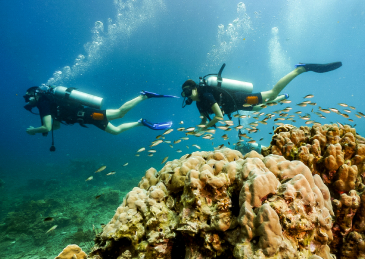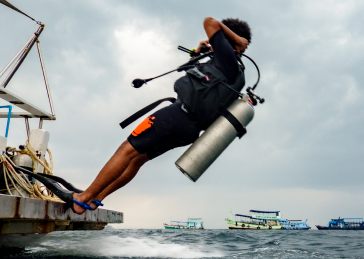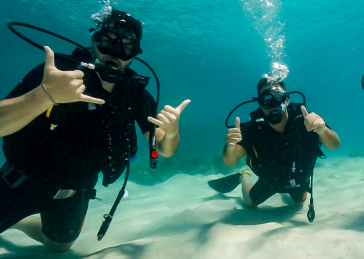Modified 9th June 2025
The 3 Magnificent Barracuda Species of Koh Tao: Silver Predators of Thailand’s Waters
Among the impressive marine predators that patrol Koh Tao’s tropical waters, barracuda stand out as some of the most captivating encounters for divers. While many visitors recognize barracuda as a single species, Koh Tao actually hosts three distinct types, each with unique characteristics, behaviors, and preferred habitats that make them fascinating subjects for underwater observation.
Understanding the differences between these silver predators enhances every dive experience, whether you’re witnessing the spectacular “barracuda tornadoes” at Chumphon Pinnacle or encountering a solitary Great Barracuda patrolling the edges of Shark Island’s rocky formations. These encounters represent just a fraction of Koh Tao’s incredible marine biodiversity.
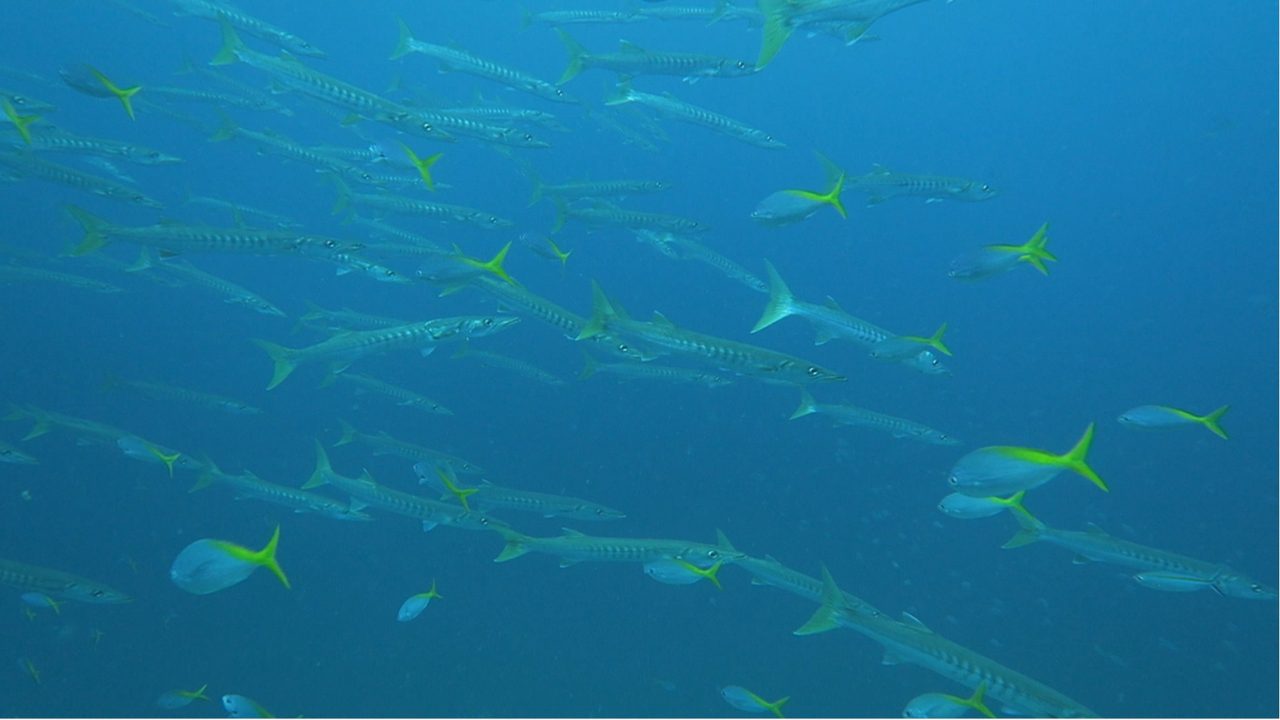
Barracuda Species Comparison Chart
| Species | Scientific Name | Visual Characteristics | Size | Best Observation Sites |
|---|---|---|---|---|
| Great Barracuda | Sphyraena barracuda | Silver-gray body with greenish tint. Dark bars/spots that fade with age. Pronounced underjaw with visible teeth. Crescent-shaped tail with white tips. | Up to 1.8m (6ft) | Shark Island, White Rock, Chumphon Pinnacle, Hin Pee Wee |
| Chevron Barracuda | Sphyraena putnamae | Silver body with distinctive V-shaped (chevron) markings along sides. More slender build. Forked tail fin, typically blackish without white tips. | 60-90cm (2-3ft) | Chumphon Pinnacle, Southwest Pinnacle, Sail Rock, Twins |
| Pickhandle Barracuda | Sphyraena jello | Silver body with wavy bars along sides. Black tips on fins. Distinctive yellowish caudal (tail) fin. Most slender profile. | 40-60cm (16-24in) | Japanese Gardens, Twins, Southwest Pinnacle, Chumphon Pinnacle |
Interactive Barracuda Identification Quiz
Test Your Barracuda Knowledge
Can you identify the different barracuda species based on their characteristics? Take this quick quiz to test your knowledge:
1. You encounter a barracuda that’s 1.5 meters long with visible teeth and dark bars that appear faded. Which species is this?
2. You see a massive school of barracuda forming a tornado-like spiral at Chumphon Pinnacle. What species are you most likely observing?
3. A small barracuda with a distinctive yellow tail fin and black-tipped fins swims by. Which species is this?
The Great Barracuda (Sphyraena barracuda)
Physical Characteristics
En Great Barracuda reigns as the largest of Koh Tao’s three barracuda species, with specimens reaching impressive lengths of up to 1.8 meters (6 feet). These formidable predators possess elongated, torpedo-shaped bodies perfectly designed for explosive bursts of speed, with their pronounced underjaw showcasing large, widely-spaced teeth that remain visible even when their mouths are closed.
Their distinctive coloration features a silvery-gray base with a greenish tint across the upper body, often displaying dark bars or spots along their sides. These markings characteristically fade as the fish matures, with larger specimens appearing more uniformly silver. The combination of their imposing size and somewhat intimidating appearance makes Great Barracuda encounters truly memorable for divers.
Behavior and Hunting Patterns
Unlike their schooling relatives, Great Barracudas are primarily solitary hunters that patrol reef edges and drop-offs. They often hover motionless in mid-water while surveying their territory, making them excellent photographic subjects as they frequently maintain position when approached respectfully by divers.
Their hunting strategy involves explosive acceleration—reaching speeds over 35 mph—to ambush prey with remarkable efficiency. As opportunistic feeders, they primarily target fish like mullet, groupers, and snappers, occasionally hunting squid and shrimp when opportunities arise.
Premier location for resident Great Barracudas patrolling rocky outcroppings and reef edges.
Deeper sections frequently host larger solitary specimens in open water areas.
Great Barracudas often lurk around reef structure edges, particularly during morning dives.
Occasional appearances by large solitary specimens, especially in deeper sections.
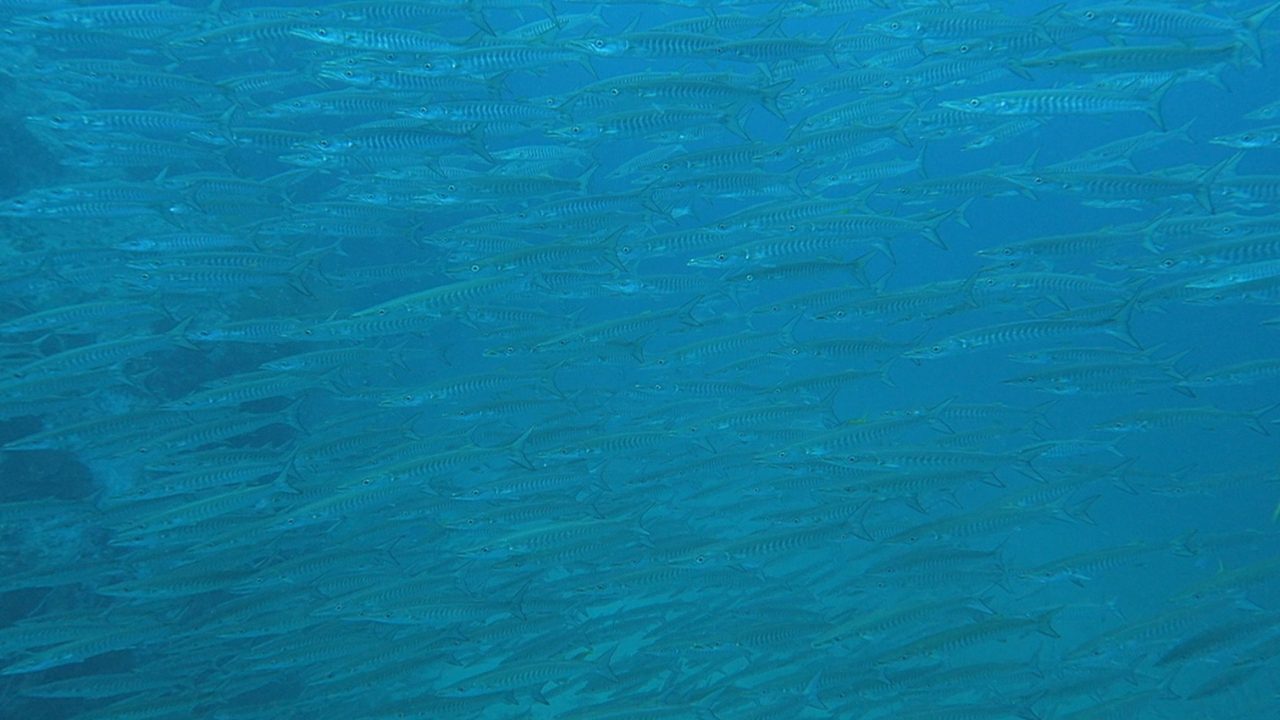
The Chevron Barracuda (Sphyraena putnamae)
Distinctive Markings and Size
Chevron Barracudas represent the medium-sized members of Koh Tao’s barracuda family, typically growing to 60-90 cm (2-3 feet) in length. Their name derives from the distinctive chevron-shaped or V-shaped marks running along their silvery sides, creating beautiful patterns that become especially visible when these fish form their characteristic schools.
Compared to Great Barracudas, Chevrons possess more slender builds with proportionally smaller heads and less pronounced teeth. Their relatively large eyes provide excellent vision for hunting in various lighting conditions, from bright surface waters to deeper, dimmer environments.
Spectacular Schooling Behavior
The most remarkable characteristic of Chevron Barracudas is their incredible schooling behavior. Unlike their solitary Great Barracuda cousins, Chevrons form massive schools numbering in the hundreds or thousands, creating mesmerizing tornado-like formations that spiral through the water column.
These schools typically form during daylight hours, particularly in early morning and late afternoon periods. Their synchronized swimming creates dazzling visual effects as sunlight reflects off their silvery bodies, serving both as protection against larger predators and as coordination for hunting activities.
The Pickhandle Barracuda (Sphyraena jello)
Smallest but Most Distinctive
En Pickhandle Barracuda represents the smallest of Koh Tao’s three species, typically reaching lengths of 40-60 cm (16-24 inches). Despite their smaller size, they possess highly distinctive characteristics that make identification straightforward for observant divers.
Their predominantly silver coloration features a bluish tint on the upper body and displays dark bars or blotches along their sides. However, their most distinctive feature is the yellowish tail fin combined with black tips on various fins, creating a unique appearance that distinguishes them from their larger relatives.
Social Behavior and Habitat Preferences
Pickhandle Barracudas typically form small to medium-sized schools that rarely reach the massive numbers characteristic of Chevron Barracudas. These schools maintain looser formations and display more active behavior, constantly moving rather than forming stable, tornado-like structures.
They commonly inhabit reef areas, rubble zones, and sandy areas between coral formations, making them accessible to both scuba divers and snorkelers at various depths around Koh Tao.
Proper Positioning Around Barracuda Schools
- Position yourself to the side of a barracuda school
- Maintain minimum distance of 3-4 meters
- Stay at same depth level as the school when possible
- Move slowly and deliberately near any barracuda
- Let the school circle around you rather than following
- Spread out if diving in a group for better viewing
- Remain relatively stationary for best tornado experiences
- Position directly in path of moving school
- Try to swim through or split up a school
- Make sudden movements that could scatter school
- Approach from above or below the school
- Use flash photography or bright strobes
- Chase or follow schools aggressively
- Cluster together in groups near schools
Safety Guidelines for Barracuda Encounters
- Maintain Distance: Keep at least 3-4 meters from barracudas, especially solitary Great Barracudas
- Controlled Movements: Move slowly and deliberately to avoid startling these powerful predators
- No Flash Photography: Avoid strobes or flash that can disorient or agitate barracudas
- Remove Shiny Objects: Cover or remove jewelry, watches, and reflective dive computer faces
- Respect Wild Behavior: Never attempt to touch, feed, or chase barracudas
- Proper Positioning: Position to the side rather than in the path of moving schools
Best Times and Locations for Barracuda Sightings
The peak season for witnessing spectacular barracuda schools, particularly the famous “barracuda tornadoes” formed by Chevron Barracudas, occurs from March through September. The largest and most impressive formations typically appear between May and July, with Chumphon Pinnacle offering the most reliable sightings during early morning dives. For comprehensive information about optimal diving conditions throughout the year, seasonal planning can significantly enhance your barracuda viewing opportunities.
Great Barracudas can be encountered year-round at various sites, while Pickhandle Barracudas form their smaller schools most actively during morning hours in shallower sites regardless of season. Understanding these patterns helps divers plan their underwater encounters for maximum barracuda viewing opportunities. Before visiting, consider reviewing transportation options to reach Koh Tao for your barracuda diving adventure.
Ready to witness the spectacular barracuda species that make Koh Tao a world-renowned diving destination?
Join La Bombona Diving for unforgettable encounters with Great, Chevron, and Pickhandle Barracudas at the island’s premier dive sites. Our experienced guides know exactly when and where to find these silver predators.
- Expert guides who know barracuda behavior patterns
- Small group sizes for optimal barracuda viewing
- Professional instruction on safe positioning around schools
- Photography tips for capturing barracuda encounters
- Flexible scheduling for peak barracuda activity times
Sail Rock Diving Trip: ฿2,800 – Full day adventure with 2 dives including guaranteed barracuda encounters
Book Your Barracuda AdventureDay trip: 5:45 AM – 1:00 PM | 2 spectacular dives | Professional dive guides
Conservation and Responsible Diving
While barracuda populations around Koh Tao remain relatively healthy, they face challenges including overfishing in surrounding waters, habitat degradation from coastal development, climate change impacts on coral reef ecosystems, and plastic pollution affecting their prey species. Learn more about ongoing conservation efforts protecting Koh Tao’s marine environment.
Local conservation efforts, including marine protected areas and sustainable fishing practices, help protect these magnificent predators. Dive centers and marine conservation organizations conduct regular monitoring of barracuda populations to track their health and numbers.
By choosing responsible dive operators and practicing environmentally conscious diving, visitors help ensure future generations can enjoy encounters with all three remarkable barracuda species that make Koh Tao’s underwater world so special. These magnificent predators are just one highlight of the diverse marine life ecosystem that makes this destination truly exceptional.
Frequently Asked Questions About Barracuda in Koh Tao
Bucea con LBD: tu puerta a la exploración submarina
Whether you’re a curious beginner or a seasoned pro, our school is your portal to the wonders of scuba diving. Join us into the world beneath the waves.
¿LISTO PARA EMPEZAR?
Consulta nuestros cursos de buceo en Koh Tao
